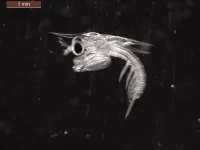(Press-News.org) Primary care practitioners often over-estimate the likelihood of a patient having a medical condition based on reported symptoms and laboratory test results. Such overestimations can lead to overdiagnosis and overtreatment, according to a recent study conducted by researchers at the University of Maryland School of Medicine (UMSOM) published in JAMA Internal Medicine.
"A large gap exists between practitioner estimates and scientific estimates of the probability of disease," said study leader Daniel Morgan, MD, a Professor of Epidemiology & Public Health at UMSOM. "Practitioners who overestimate the probability of disease might use that overestimation when deciding whether to initiate therapy, which could lead to the overuse of risky medications and procedures."
To conduct the study, Dr. Morgan and his colleagues surveyed 553 primary health practitioners, including residents, attending physicians, nurse practitioners and physician assistants, in Maryland and seven other states. Survey respondents were asked to determine how well they could estimate the risk of four well-known health conditions based on hypothetical diagnostic scenarios. The researchers found, based on symptoms and test results, that health care providers significantly overestimated the likelihood of conditions. For example, health care providers, on average, estimated a 70 percent likelihood of cardiac ischemia in patients who had a positive finding on a stress test. In reality, based on evidence from medical studies, the real likelihood of cardiac ischemia is 2 to 11 percent.
The study also found that survey respondents estimated a 50 percent risk of breast cancer after a positive finding on a mammogram when evidence suggests 3 to 9 percent chance of breast cancer. They estimated an 80 percent likelihood of a urinary tract infection from a positive urine culture, and the vast majority of survey respondents said they would treat with antibiotics in these cases. The real risk of a UTI with a positive urine culture, however, is at most 8 percent.
"Solving this problem is not about asking health care providers to memorize numbers or practice math in order to improve their understanding of risks," Dr. Morgan said. "We should, however, use probability and better utilization of decision-making tools to help them make better estimates."
He developed a free tool called Testing Wisely, funded by the National Institutes of Health, that is designed to improve clinician understanding and ordering of diagnostic tests to make patient care safer. The site also includes a risk calculator to assess patients' symptoms, exposure, and local positivity rates where they live to calculate their individual risk of having COVID-19.
"Informed medical decision-making is incredibly important, and physicians should have access to tools that make their job easier and improve patient safety," said E. Albert Reece, MD, PhD, MBA, Executive Vice President for Medical Affairs, UM Baltimore, and the John Z. and Akiko K. Bowers Distinguished Professor and Dean, University of Maryland School of Medicine. "This study demonstrates the need for better decision-making tools to help healthcare providers provide the best possible care to their patients."
INFORMATION:
About the University of Maryland School of Medicine
Now in its third century, the University of Maryland School of Medicine was chartered in 1807 as the first public medical school in the United States. It continues today as one of the fastest growing, top-tier biomedical research enterprises in the world -- with 45 academic departments, centers, institutes, and programs; and a faculty of more than 3,000 physicians, scientists, and allied health professionals, including members of the National Academy of Medicine and the National Academy of Sciences, and a distinguished two-time winner of the Albert E. Lasker Award in Medical Research. With an operating budget of more than $1.2 billion, the School of Medicine works closely in partnership with the University of Maryland Medical Center and Medical System to provide research-intensive, academic and clinically based care for nearly 2 million patients each year. The School of Medicine has more than $563 million in extramural funding, with most of its academic departments highly ranked among all medical schools in the nation in research funding. As one of the seven professional schools that make up the University of Maryland, Baltimore campus, the School of Medicine has a total population of nearly 9,000 faculty and staff, including 2,500 student trainees, residents, and fellows. The combined School of Medicine and Medical System ("University of Maryland Medicine") has an annual budget of nearly $6 billion and an economic impact more than $15 billion on the state and local community. The School of Medicine, which ranks as the 8th highest among public medical schools in research productivity, is an innovator in translational medicine, with 600 active patents and 24 start-up companies. The School of Medicine works locally, nationally, and globally, with research and treatment facilities in 36 countries around the world. Visit medschool.umaryland.edu
The discovery of ancient kumara pits just north of Dunedin dating back to the 15th century have shone a light on how scientific evidence can complement mātauranga Maori around how and where the taonga were stored hundreds of years ago.
A new study published in the science journal PLOS ONE reports that early Polynesians once stored kumara - American sweet potato - in pits dug into sand dunes at Purākaunui, eastern Otago, less than 30km north of Dunedin. The pits were first discovered in 2001 and are found over 200km south of the currently accepted South Island limit of cooler-climate Māori kumara storage.
These Purākaunui features have the novel form of semi-subterranean, rectangular pits used for the cool seasonal storage ...
The brain possesses a complex architecture of functional networks as its information-processing machinery. Is the brain's network architecture itself a target of disease? If so, which networks are associated with which diseases? What can this tell us about the underlying causes of brain disorders?
Building on the extraordinary progress in neuroscience made over the past 30 years, researchers from The University of Texas Health Science Center at San Antonio (UT Health San Antonio) published a study of 43 brain disorders - both psychiatric and neurologic - and strongly affirmed ...
EUGENE, Ore. -- April 29, 2021 -- An analysis of Twitter activity between March 1 and Aug. 1, 2020, found strong support by U.S. users for wearing face coverings and that a media focus on anti-mask opinions fueled the rhetoric of those opposed, report University of Oregon researchers.
The study, published April 28 in the journal PLOS ONE, initially focused on linguistics, zeroing in on the language associated with hashtags during the study period, which began a month before the Centers for Disease Control and Prevention recommended mask-wearing to protect against COVID-19 infection.
However, to better understand that semantics, which were found to be polarized, angry and emotionally ...
Adult mantis shrimp pack an explosive punch that can split water, but no crustacean emerges fully formed. Minute larvae can undergo six or seven transformations before emerging as fully developed adults and limbs and manoeuvres develop over time. So, when do mantis shrimp larvae acquire the ability to pulverise their dinner and how powerful are the punches that these mini crustaceans pack? 'We knew that larval mantis shrimp have these beautiful appendages; Megan Porter and Eve Robinson at the University of Hawaii had captured normal videos of a couple of strikes a few years ago', says Jacob Harrison from Duke University, USA. So, he packed up ...
Adult heterosexual women and men are often jealous about completely different threats to their relationship. These differences seem to establish themselves far sooner than people need them. The finding surprised researchers at the Norwegian University of Science and Technology (NTNU) who studied the topic.
"You don't really need this jealousy until you need to protect yourself from being deceived," says Professor Leif Edward Ottesen Kennair at NTNU's Department of Psychology.
Romantic jealousy can be experienced as horrible at its worst. But jealousy associated with a partner's infidelity has clearly been ...
More than a quarter of American infants in 2018 had not received common childhood vaccines that protect them from illnesses such as polio, tetanus, measles, mumps and chicken pox, new research from the University of Virginia School of Medicine reveals.
Only 72.8% of infants aged 19-35 months had received the full series of the seven recommended vaccines, falling far short of the federal government's goal of 90%. Those less likely to complete the vaccine series include African-American infants, infants born to mothers with less than a high-school education and infants in families with incomes below the federal poverty line.
The researchers warn that failure to complete the vaccine series leaves children at increased risk of infection, illness and death. It also reduces the herd ...
Human decision-making depends on the flexible processing of complex information, but how the brain may adapt processing to momentary task demands has remained unclear. In a new article published in the journal Nature Communications, researchers from the Max Planck Institute for Human Development have now outlined several crucial neural processes revealing that our brain networks may rapidly and flexibly shift from a rhythmic to a "noisy" state when the need to process information increases.
Driving a car, deliberating over different financial options, or even pondering different life paths requires us to process an overwhelming amount of information. But not all decisions pose equal demands. In some situations, decisions are easier because we already know which ...
People with diabetes are at increased risk of developing a severe course of COVID-19 compared to people without diabetes. The question to be answered is whether all people with diabetes have an increased risk of severe COVID-19, or whether specific risk factors can also be identified within this group. A new study by DZD researchers has now focused precisely on this question and gained relevant insights.
The COVID-19 pandemic poses unprecedented challenges to science and the health sector. While in some people with a SARS-CoV-2 infection the disease is hardly noticeable, in others ...
Exposure before birth to persistent organic pollutants (POPs)-- organochlorine pesticides, industrial chemicals, etc.--may increase the risk in adolescence of metabolic disorders, such as obesity and high blood pressure. This was the main conclusion of a study by the Barcelona Institute for Global Health (ISGlobal), a research centre supported by the "la Caixa" Foundation. The study was based on data from nearly 400 children living in Menorca, who were followed from before birth until they reached 18 years of age.
POPs are toxic, degradation-resistant ...
A top-level international research team including researchers from the University of Eastern Finland has developed a new algorithm for the diagnostics of dementia. The algorithm is based on blood and cerebrospinal fluid biomarker measurements. These biomarkers can be used to aid setting of an exact diagnosis already in the early phases of dementia.
Researchers from the University of Eastern Finland and the University of Oulu in collaboration with an international team have created a new diagnostic biomarker-based algorithm for the diagnostics of dementia. The team is led by Professor Barbara Borroni from the University of Brescia, Italy. The article was published in the Diagnostics journal.
The accurate diagnosis ...


